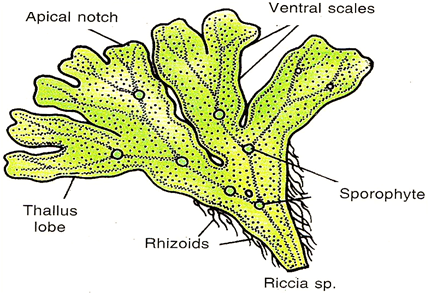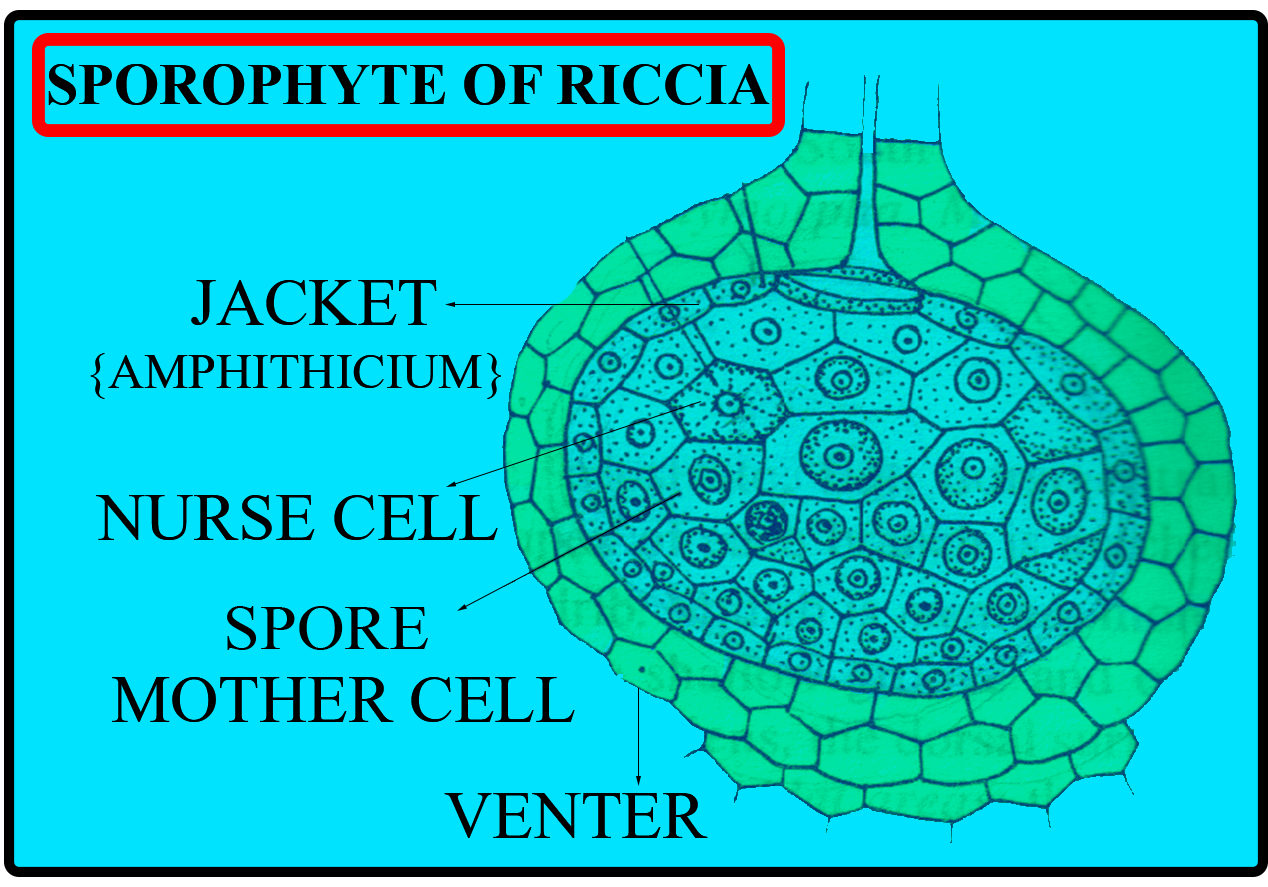
Sporophyte of Riccia contains
(a) Spores, elaters, and nutritive cells
(b) Spores and nutritive cells
(c) Elaters and spores
(d) Spores only
Answer
427.5k+ views
Hint: Riccia is an aquatic, thallose liverwort whose capsule remains lodged within the thallus of gametophytes. Riccia's sporophyte is the simplest since it contains only capsules, missing both the foot and seta.
Complete answer:
A bryophyte's sporophyte (moss, liverwort, or hornwort) , usually consists of one foot, seta, and capsule. The mature capsule is filled with spores mixed with sterile cells or elaters and opens into valves by splitting. In Bryopsida, elders are absent. Elaters are diploid, spindle-shaped, elongated, hygroscopic structures with 2 spiral bands that help to dispersal spores.
Not all spore mother cells do develop spores in certain liverworts. Instead, several spore mother cells abort to become sterile nutritive or nurse cells that help nourish the spores that grow. This occurs for example in Riccia and Sphaerocarpos, the thallose liverwort genera.


So, the correct answer is, ‘Spores and nutritive cells’.
Additional Information:
The riccia sporophyte consists of a peripheral layer of cells that form the wall of the capsule and a central mass of the mother cell that contains spores.
The diploid zygote is the first generation of sporophyte cells. Shortly after the fertilization this cell secretes a membrane around it and enlarges in size and almost fills the center cavity. Subsequently, it undergoes division and hits the two-celled stage. The upper cell is called the epibasal cell, and the lower cell is called the parabasal cell. The two embryo cells (epibasal and hypobasal) further divide and give rise to a four-celled embryo stage followed by an eight-celled stage.
The embryo is subsequently separated into two parts. The outer layer is amphithecium, and endothecium is the inner mass of the cells. The amphithecium is defensive while the endothecium creates a mass of sporogenous cells.
Note: Spore Mother cells are created by sporogenous cells. Mother spore cells undergo meiotic division, forming tetrads. Thus a tetrad is composed of four spores. Only upon maturation the spores become isolated from one another. Naturally, the spores are haploid. The spores release themselves from the sporogonium on the death and decay of the thallus. The spores are small in number and probably spread by animals.
Complete answer:
A bryophyte's sporophyte (moss, liverwort, or hornwort) , usually consists of one foot, seta, and capsule. The mature capsule is filled with spores mixed with sterile cells or elaters and opens into valves by splitting. In Bryopsida, elders are absent. Elaters are diploid, spindle-shaped, elongated, hygroscopic structures with 2 spiral bands that help to dispersal spores.
Not all spore mother cells do develop spores in certain liverworts. Instead, several spore mother cells abort to become sterile nutritive or nurse cells that help nourish the spores that grow. This occurs for example in Riccia and Sphaerocarpos, the thallose liverwort genera.


So, the correct answer is, ‘Spores and nutritive cells’.
Additional Information:
The riccia sporophyte consists of a peripheral layer of cells that form the wall of the capsule and a central mass of the mother cell that contains spores.
The diploid zygote is the first generation of sporophyte cells. Shortly after the fertilization this cell secretes a membrane around it and enlarges in size and almost fills the center cavity. Subsequently, it undergoes division and hits the two-celled stage. The upper cell is called the epibasal cell, and the lower cell is called the parabasal cell. The two embryo cells (epibasal and hypobasal) further divide and give rise to a four-celled embryo stage followed by an eight-celled stage.
The embryo is subsequently separated into two parts. The outer layer is amphithecium, and endothecium is the inner mass of the cells. The amphithecium is defensive while the endothecium creates a mass of sporogenous cells.
Note: Spore Mother cells are created by sporogenous cells. Mother spore cells undergo meiotic division, forming tetrads. Thus a tetrad is composed of four spores. Only upon maturation the spores become isolated from one another. Naturally, the spores are haploid. The spores release themselves from the sporogonium on the death and decay of the thallus. The spores are small in number and probably spread by animals.
Recently Updated Pages
Express the following as a fraction and simplify a class 7 maths CBSE

The length and width of a rectangle are in ratio of class 7 maths CBSE

The ratio of the income to the expenditure of a family class 7 maths CBSE

How do you write 025 million in scientific notatio class 7 maths CBSE

How do you convert 295 meters per second to kilometers class 7 maths CBSE

Write the following in Roman numerals 25819 class 7 maths CBSE

Trending doubts
State and prove Bernoullis theorem class 11 physics CBSE

What are Quantum numbers Explain the quantum number class 11 chemistry CBSE

Write the differences between monocot plants and dicot class 11 biology CBSE

1 ton equals to A 100 kg B 1000 kg C 10 kg D 10000 class 11 physics CBSE

State the laws of reflection of light

One Metric ton is equal to kg A 10000 B 1000 C 100 class 11 physics CBSE




